

Welcome to the Interfaith Alliance. Project Interfaith. Interfaith. The Open Source Religion Social Network - The mixing of religious and non-religious beliefs in an individual. All Religions are One. One of two known impressions of the title page from All Religions are One, printed c1795 All Religions are One is the title of a series of philosophical aphorisms by William Blake, written in 1788.
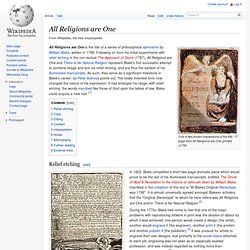
Following on from his initial experiments with relief etching in the non-textual The Approach of Doom (1787), All Religions are One and There is No Natural Religion represent Blake's first successful attempt to combine image and text via relief etching, and are thus the earliest of his illuminated manuscripts. As such, they serve as a significant milestone in Blake's career; as Peter Ackroyd points out, "his newly invented form now changed the nature of his expression. It had enlarged his range; with relief etching, the words inscribed like those of God upon the tables of law, Blake could acquire a new role. Relief etching[edit]
Bahá'í Faith and the unity of religion. The Unity of Religion is a core teaching in the Bahá'í Faith that states that there is a fundamental unity of many of the world's religions.[1] The principle states that the teachings of the major religions are part of a single plan directed from the same God.[2] It is one of the core teachings of the Bahá'í Faith, alongside the unity of God, and the unity of humanity.[3] The Bahá'í teachings state that there is but one religion which is progressively revealed by God, through prophets/messengers, to mankind as humanity matures and its capacity to understand also grows.
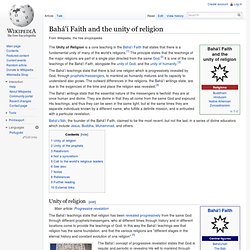
The Golden Rule. Uniting & oneness. The Lighted Path. Over the past year, we have been humbled by the willing requests of people who have contacted us after seeing our films with the question “What can I do to help?”
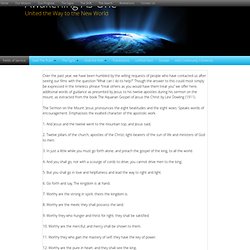
Though the answer to this could most simply be expressed in the timeless phrase “treat others as you would have them treat you” we offer here, additional words of guidance as presented by Jesus to his twelve apostles during his sermon on the mount, as extracted from the book The Aquarian Gospel of Jesus the Christ by Levi Dowling (1911). The Formula for Creating Heaven on Earth v3.0 - the-formula-chart-v3.0-twopages.pdf. A NATION FOR PEACE.
Religions for Peace. PeaceNext. Parliament of the World's Religions. Chicago Meeting, 1893.
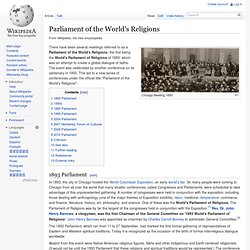
The Invincibility of a Vision. Order of Universal Interfaith - Home. Council for a Parliament of the World's Religions. Www.imamsrabbisforpeace.org - Le Congrès Mondial des Imams et Rabbins pour la Paix - Accueil. Religious Tolerance. My Journey into Interreligious Dialogue: Part I.
Monastic Interreligious Dialogue. Society: Religion and Spirituality: Interfaith. Interfaith dialog. (left to right) George Carey, Archbishop of Canterbury (1991–2002), Jonathan Sacks, Chief Rabbi (UK), Mustafa Cerić, Grand Mufti of Bosnia, Jim Wallis, Sojourners, USA. 2009 World Economic Forum in Davos, Switzerland.
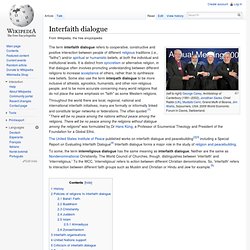
The term interfaith dialogue refers to cooperative, constructive and positive interaction between people of different religious traditions (i.e., "faiths") and/or spiritual or humanistic beliefs, at both the individual and institutional levels. It is distinct from syncretism or alternative religion, in that dialogue often involves promoting understanding between different religions to increase acceptance of others, rather than to synthesize new beliefs. Some also use the term interpath dialogue to be more inclusive of atheists, agnostics, humanists, and other non-religious people, and to be more accurate concerning many world religions that do not place the same emphasis on "faith" as some Western religions. History[edit] Fetzer Institute. International Society for Science and Religion. Zygon Center for Religion and Science. United Religions Initiative.
United Religions Initiative. The United Religions Initiative (URI) is an international, grassroots, interfaith bridge-building organization modeled after the United Nations.

It aims to create social change by promoting "enduring, daily interfaith cooperation," ending "religiously motivated violence", and promoting "cultures of peace, justice, and healing for the Earth and all living beings. "[1] United Nations - Alliance of Civilizations - Home. Category:Interfaith organizations. Rencontre d'Assise. Un article de Wikipédia, l'encyclopédie libre.

La rencontre entre François d'Assise et le sultan Al-Kamel, qui a fasciné les générations suivantes, explique le choix du lieu des rencontres interreligieuses. Choix de la ville d'Assise[modifier | modifier le code] Les différentes rencontres[modifier | modifier le code] La première rencontre d’Assise crée la surprise par son caractère inédit ; elle est annoncée par le pape Jean-Paul II le 25 janvier 1986 à l'occasion de l’année internationale de la paix proclamée par l’ONU, dans le contexte de la guerre froide et de la guerre du Liban.
La rencontre a lieu le 27 octobre suivant et réunit 130 responsables religieux du monde entier[2],[3]. La deuxième rencontre, en 1993, se déroule sur fond de conflits dans les pays de l'ex-Yougoslavie. Assise 1986[modifier | modifier le code] Temple of Understanding.